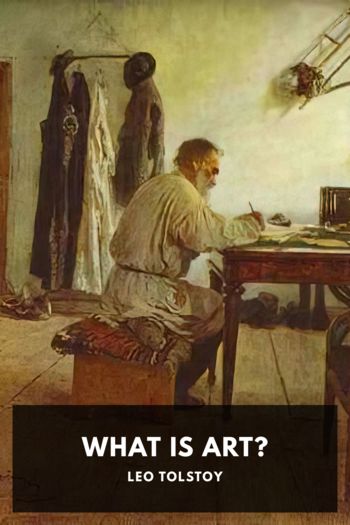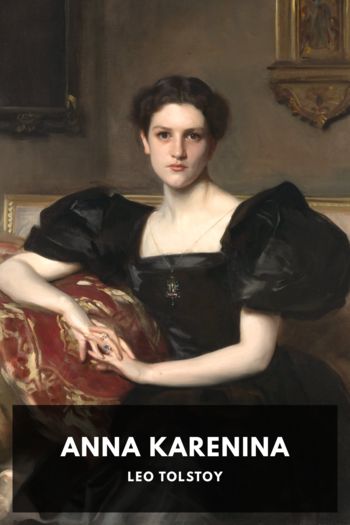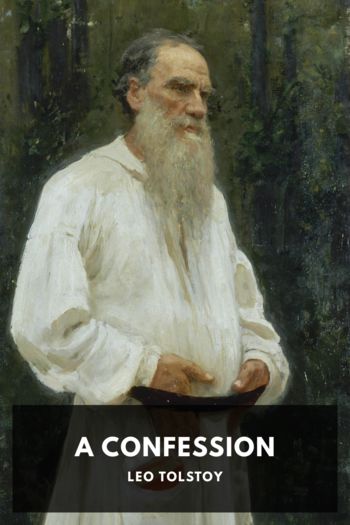What Is Art? by Leo Tolstoy (english readers .txt) 📕

- Author: Leo Tolstoy
Book online «What Is Art? by Leo Tolstoy (english readers .txt) 📕». Author Leo Tolstoy
If the religion places the meaning of life in worshipping one God and fulfilling what is regarded as His will, as was the case among the Jews, then the feelings flowing from love to that God, and to His law, successfully transmitted through the art of poetry by the prophets, by the psalms, or by the epic of the book of Genesis, is good, high art. All opposing that, as for instance the transmission of feelings of devotion to strange gods, or of feelings incompatible with the law of God, would be considered bad art. Or if, as was the case among the Greeks, the religion places the meaning of life in earthly happiness, in beauty and in strength, then art successfully transmitting the joy and energy of life would be considered good art, but art which transmitted feelings of effeminacy or despondency would be bad art. If the meaning of life is seen in the well-being of one’s nation, or in honouring one’s ancestors and continuing the mode of life led by them, as was the case among the Romans and the Chinese respectively, then art transmitting feelings of joy at sacrificing one’s personal well-being for the common weal, or at exalting one’s ancestors and maintaining their traditions, would be considered good art; but art expressing feelings contrary to this would be regarded as bad. If the meaning of life is seen in freeing oneself from the yoke of animalism, as is the case among the Buddhists, then art successfully transmitting feelings that elevate the soul and humble the flesh will be good art, and all that transmits feelings strengthening the bodily passions will be bad art.
In every age, and in every human society, there exists a religious sense, common to that whole society, of what is good and what is bad, and it is this religious conception that decides the value of the feelings transmitted by art. And therefore, among all nations, art which transmitted feelings considered to be good by this general religious sense was recognised as being good and was encouraged; but art which transmitted feelings considered to be bad by this general religious conception, was recognised as being bad, and was rejected. All the rest of the immense field of art by means of which people communicate one with another, was not esteemed at all, and was only noticed when it ran counter to the religious conception of its age, and then merely to be repudiated. Thus it was among all nations—Greeks, Jews, Indians, Egyptians, and Chinese—and so it was when Christianity appeared.
The Christianity of the first centuries recognised as productions of good art, only legends, lives of saints, sermons, prayers and hymn-singing, evoking love of Christ, emotion at his life, desire to follow his example, renunciation of worldly life, humility, and the love of others; all productions transmitting feelings of personal enjoyment they considered to be bad, and therefore rejected: for instance, tolerating plastic representations only when they were symbolical, they rejected all the pagan sculptures.
This was so among the Christians of the first centuries, who accepted Christ’s teaching, if not quite in its true form, at least not in the perverted, paganised form in which it was accepted subsequently.
But besides this Christianity, from the time of the wholesale conversion of nations by order of the authorities, as in the days of Constantine, Charlemagne, and Vladimir, there appeared another, a Church Christianity, which was nearer to paganism than to Christ’s teaching. And this Church Christianity, in accordance with its own teaching, estimated quite otherwise the feelings of people and the productions of art which transmitted those feelings.
This Church Christianity not only did not acknowledge the fundamental and essential positions of true Christianity—the immediate relationship of each man to the Father, the consequent brotherhood and equality of all men, and the substitution of humility and love in place of every kind of violence—but, on the contrary, having set up a heavenly hierarchy similar to the pagan mythology, and having introduced the worship of Christ, of the Virgin, of angels, of apostles, of saints, and of martyrs, and not only of these divinities themselves, but also of their images, it made blind faith in the Church and its ordinances the essential point of its teaching.
However foreign this teaching may have been to true Christianity, however degraded, not only in comparison with true Christianity, but even with the life-conception of Romans such as Julian and others; it was, for all that, to the barbarians who accepted it, a higher doctrine than their former adoration of gods, heroes, and good and bad spirits. And therefore this teaching was a religion to them, and on the basis of that religion the art of the time was assessed. And art transmitting pious adoration of the Virgin, Jesus, the saints and the angels, a blind faith in and submission to the Church, fear of torments and hope of blessedness in a life beyond the grave, was considered good; all art opposed to this was considered bad.
The teaching on the basis of which this art arose was a perversion of Christ’s teaching, but the art which sprang up on this perverted teaching was nevertheless a true art, because it corresponded to the religious view of life held





Comments (0)